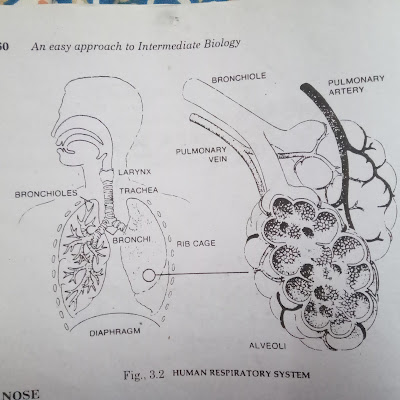Q. 4: describe the structure and function of various parts of the respiratory system of man. or what are the different parts of the air passageway of man?
Ans:- AIR PASSAGE WAYS
(RESPIRATORY SYSTEM OF MAN)
The respiratory system of man consists of lungs and air passage. The air passage consists of following parts
l- Nose
2- Pharynx.
3- Larynx or voice box
4- Trachea or windpipe
4 -Bronchus
6- Bronchioles
7-Air sacs
8-Lungs

HUMAN RESPIRATORY SYSTEM

NOSE
The nose has two nasal cavities, each of which is lined with a mucous membrane consisting largely of ciliated epithelial cells. Each nasal cavity is subdivided into three passageways formed by the projection of several bones from the lateral walls of the nasal cavities. Air passes through the nostrils into the nasal cavities. Hair is present in the nasal cavities which trap the large dust particles. When air passes through the upper part of the nose it is warmed. moistened and filtered of smaller foreign particles by the mucous membrane. The nasal cavities open into the throat or pharynx by two internal openings.
PHARYNX
The pharynx is a muscular passage. also lined with mucous membrane. The air enters from the pharynx into the larynx.

Relationship between blood capillaries and air-sacs.

LARYNX OR VOICE BOX
It
is a complex cartilaginous structure present on the upper end of the trachea. One of the cartilages, called the epiglottis, is controlled by the
muscles and has hinge-like action. It serves as a lid that automatically covers
the opening of the larynx during swallowing so that the entry of food or
liquids into the larynx is prevented.
The cavity of the larynx is called the glottis
and is also lined by the membrane which is stretched across it. There are two
thin-edged fibrous bands called vocal cords, that help in voice production. When
air passes out of the lungs and over the vocal cords, it causes them to
vibrate. This produces sounds that are the basis of our speech and song.
TRACHEA OR WINDPIPE
It is a tubular structure lying ventral to
the esophagus. It extends to the chest cavity or thorax where it is divided
into right and left bronchi, one leading to each lung. The trachea wall has a
series of C-shaped cartilage rings that prevent the trachea from collapsing
and thus maintaining an open passageway for the air.
BRONCHUS AND BRONCHIOLES
On entering the lung, each bronchus divides
and subdivides into smaller and smaller bronchi. When the bronchi attain a
diameter of 1 mm or less, then they are called bronchioles. The bronchi also
have the cartilage rings like the trachea but the rings are gradually replaced by
irregularly distributed cartilage plates. While the bronchioles totally lack
them and are made up of mainly circularly arranged smooth muscles and elastic
fibers.
AIR SACS
The
bronchioles divide and subdivide into the lungs and finally open into a very
large number of air sacs that form the functional units of the lungs. Fach air
sac looks like a cluster of grapes and consists of several microscopic, single
cell-layered structures called alveoli. There is a rich network of blood capillaries
overlying the alveoli. These capillaries provide an excellent site for the
exchange of gases.
LUNGS
The lungs are two closed spongy sacs that
communicate to the outside by way of the trachea and the nostrils or mouth.
Each lung has millions of alveoli. They are placed in the chest cavity which is
bounded by ribs and muscles on the sides and also by a sheet of skeletal
muscles, the diaphragm, below. Both lungs are covered with a thin membrane
called the pleura which See the form of a double sac.


![How to delete Facebook account: [] Deactivate Facebook Account](https://blogger.googleusercontent.com/img/b/R29vZ2xl/AVvXsEh06I_fqO-_z3HplSTXr2174v2t9jJTQL4omEVpx7SYzEvW3GdmXSrf5_pR-lKZx5xq9rXs_ST8P6HNBK_vI4rSt9zMtgOoZRRmLZaZTSsSLn0QszuHHCPgh5XvkHIyPcspp5B4xurU4sOl/w100/image_2021-09-27_120516.jpg)


![How to new android update; [] Latest Version of Android](https://blogger.googleusercontent.com/img/a/AVvXsEiXrh_H1xc9pMCKPk7uCg3IcgEM-TvXSf_ijOtsicwbJBFUDiuJAR1qUS2IoEWHWZyYbR-EVrZK-fvVYMBPpV_7ObD5bVwK9dRkIFE3o9NpxESdGfPfGF6UOaxPV37AythWUkSspSV8jTwGTKaiZM-YHzcETXut9fEJr6PVqi8LvBxa8a3--KQVuL5OiA=w640)